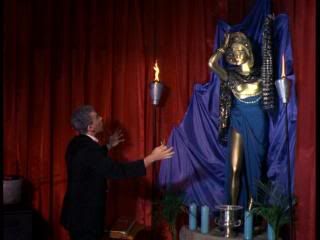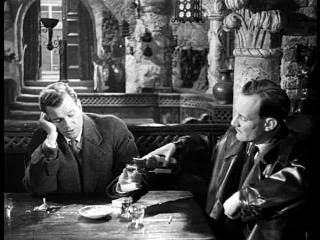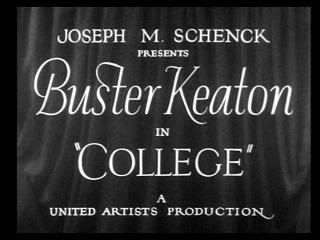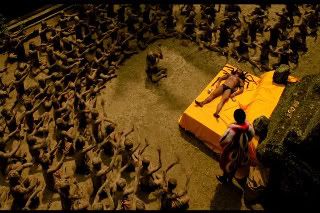
PLOT:
You mean you don't know? Ok.. here's the broad strokes. Fuad Ramses (the fuzzy eyebrowed Mal Arnold) is a caterer who, in an attempt to resurrect the Egyptian goddess Ishtar, starts butchering women and stealing their body parts. Ol' Ramses is hired to cater a party for the young Suzette Fremont (Playboy Bunny Connie Mason), who is being wooed by Det. Pete Thornton (William Kerwin) who is hot on Ramses trail. Except not really. Suzette's mom walks in on Ramses attempting to chop her daughter's head off, which sends Thornton chasing after the limping murderer. Attempting to escape in the back of a garbage truck ends up being Ramses' undoing, as he's unconvincingly crushed to death. "He died a fitting end for the garbage he was", says the police captain. So true.

REVIEW:
About Blood Feast, director Herschell Gordon Lewis famously said: "I've often referred to Blood Feast as a Walt Whitman poem. It's no good, but it was the first of its type". And indeed the film was the first to be sold solely on the copious amounts of gore onscreen, setting the stage for most of the exploitation-horror over the next four decades. It's influence can be seen in the work of filmmakers as diverse as John Waters and Eli Roth. It's had tributes and sequels and has been immortalized in the minds of fans of cult and horror cinema, along with other H.G. Lewis classics like 2000 Maniacs, The Wizard Of Gore, and Color Me Blood Red. The impact of the film simply cannot be denied.
But it's certainly no good.
The performance range from passable to pitiful, with Mal Arnold's wild overacting clashing harshly with Connie Mason's mannequin-like performance. William Kerwin is solid in the lead, but is made to look inept and ineffective by a script that seems to have been made up as the creators went along. The direction is pedestrian, and the effects are totally primitive. The film barely has enough action to fill its scant 70 minute run time, and tension and suspense is almost non-existent.

But, frankly, that's not why anyone came to see this film. They went to see copious amounts of violence, and the film certainly delivers that. From the opening scene showing a young lady getting her leg hacked off, we know we're watching something totally different from the nudie pictures popular at the time. All the usual skin and sex is traded for bloodshed, and in fact the film features absolutely no nudity or coarse language. Lewis (and producer David Friedman) figured that they didn't want to give censors any more ammunition than was necessary.
The film remains watchable for a combination of historic importance, and because of its enduring ridiculousness. Everything feels exaggerated in one way or another, with the unconvincing effects preventing the audience from being too disgusted by the whole thing. The final chase scene is particularly laughable, as Ramses limps slowly across a desert but still manages to out-pace the officers running after him.

Of a much higher quality than the rest of the film is Lewis' memorable soundtrack, particularly the pounding drums of the main theme. In the commentary Lewis mentions spending longer on the soundtrack than on the actual film, and it shows. Lewis was an amazingly economical director, and certainly didn't waste time or film in the process of making a feature.
For all the criticisms of the film itself, the DVD from Image Entertainment (and Something Weird Video) is an absolute delight. While its low-budget origins are obvious, the film looks bright and colorful. The full screen transfer is as close to perfect as we're likely to see.
We're also treated to some wonderful (and unique) extra features:
First is the short film "Carving Magic", starring William Kerwin and the late Harvey Korman showing us the proper way to carve a number of different meats. A morbidly appropriate companion piece to the main feature. We also get the original theatrical trailer for Blood Feast, featuring the talking head of Kerwin suggesting parents and children leave the theater while the trailer ran (barf bags were sometimes provided for viewers on the film's original release). Fifty minutes(!) of incredibly rare outtakes round out the video extras, featuring (according to Lewis) almost all of the footage that was shot but not included in the film. While there is no original violence on the outtakes, there are a few shots of nudity that don't appear in the final product.

The DVD also features a second audio track featuring commentary from director H.G. Lewis and producer David Friedman. The commentary is wonderfully informative and full of funny stories from the two men who obviously have a lot of fun looking back at their fascinating careers. They go into detail in regards to the difficulties of releasing such a unique film, as well as the revolutionary way they went about marketing it. At heart, both men are (admitted) carnies, and sometimes still appear to be in awe of the success of their big score.
The special features are rounded off with a gallery of exploitation art, featuring various newspaper ads for the film as well as stills and poster art. It finishes with a nice photo of the cast and crew.

Blood Feast is essential viewing for those interested in the history of exploitation, gore or horror film-making. It quite literally changed the way films were made and marketed, and its influence is still felt. While time hasn't been kind to the effects and performances, there are still some unintentional laughs to be had, and the great DVD package by Something Weird makes the whole thing go down smoothly.
See it to say you've seen it.










































